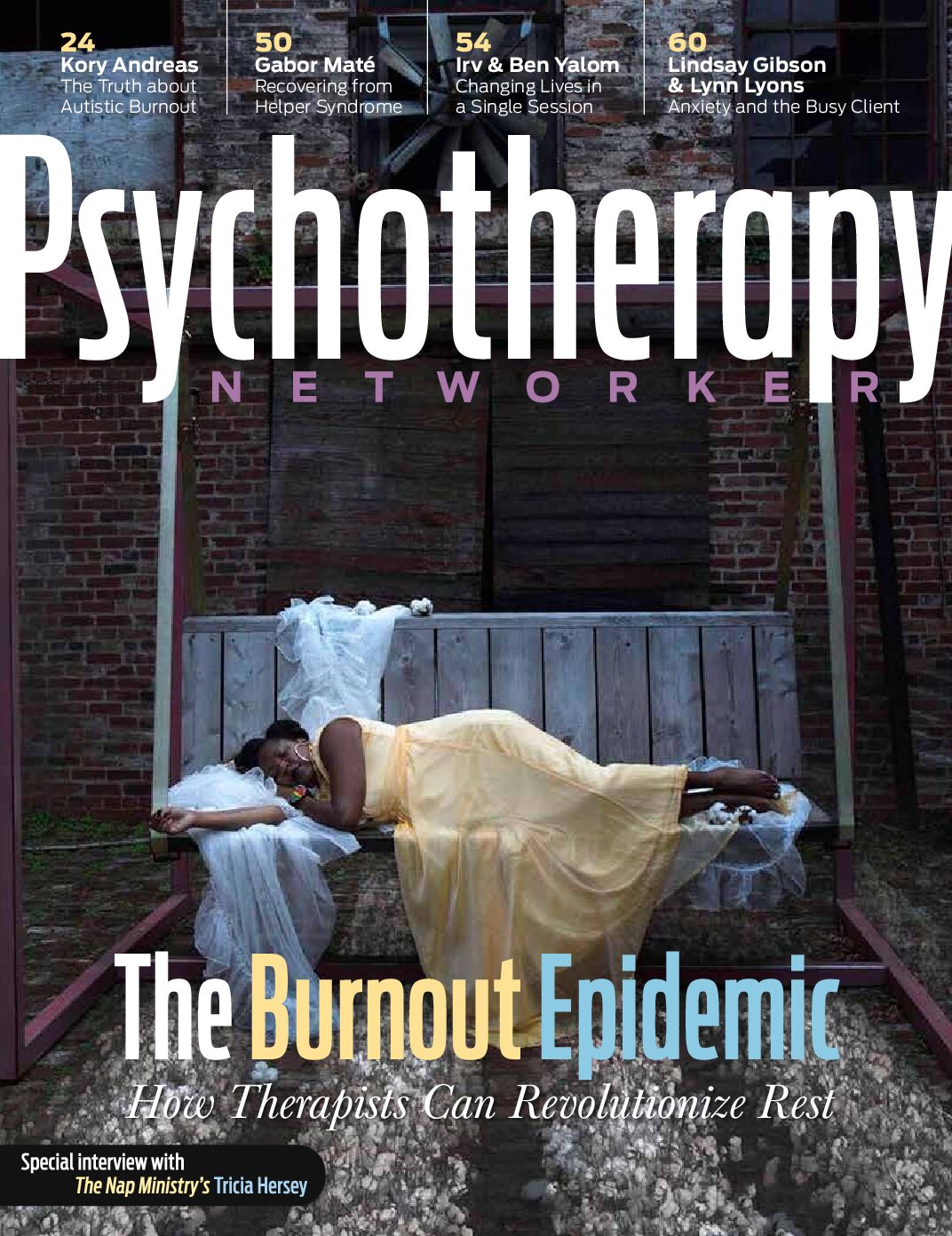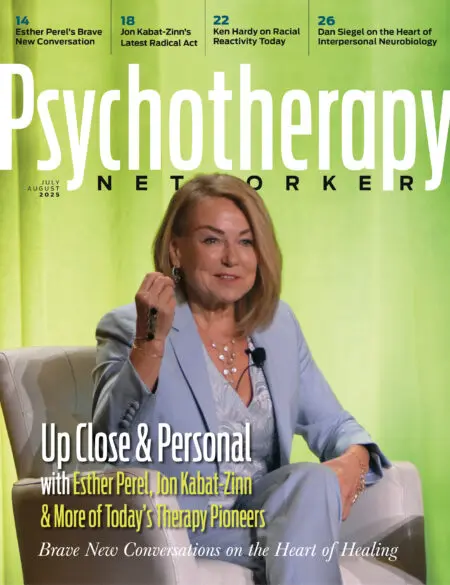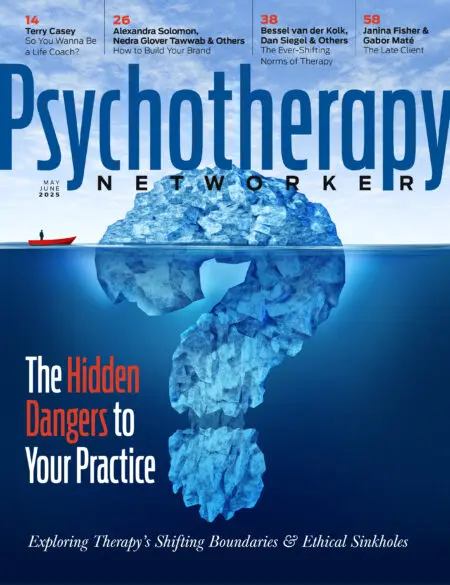As therapists, we’re taught to be master detectives, methodically investigating our clients’ symptoms in search of a culprit—the source of their pain. But if we spend too much time preoccupied with our clients’ symptoms, we’re likely to miss important clues to their hidden strengths. Over the years, I’ve learned that turning a symptom into a client’s ally, rather than a nemesis, can transform the whole experience of psychotherapy for both the therapist and client.
I didn’t always see symptoms as allies. In fact, my early training in hospital settings taught me to view symptoms as pure pathology, and evidence of impairment. Unfortunately, seeing patients as impaired made exploring their innate strengths and how their symptoms might be resources seem irrelevant to the main task of therapy: medicating, controlling, and managing pesky emotional and physiological problems. To make matters worse, clients’ belief that symptoms were their enemy validated their fear that something was terribly wrong with them. Too often I saw therapy bog down, as patients became even more helpless, stuck, and despairing, rather than moving on with their lives.
Frustrated with the limited effectiveness of the medical model of treatment, I searched for more positive approaches to psychotherapy as soon as I obtained my professional counselor’s license in 1999. I became inspired by solution-oriented methods as well as Ericksonian hypnosis, which proposed that clients have the resources within themselves to heal, based on Milton Erickson’s assertion that clients become stuck when they believe their symptoms have control over them. Solution-oriented therapist Bill O’Hanlon termed this state of powerlessness a symptom trance and warned that we therapists, too, are susceptible to falling into it if we become overly focused on symptoms as pathological. Ericksonian hypnosis uses indirect suggestions that invite clients to reclaim their power by intentionally altering and using their symptoms in the service of change.
At the same time I was learning about Ericksonian hypnosis, I began studying the neurobiology of emotion to deepen my understanding of how our brains and bodies produce emotional responses. Charles Darwin first postulated that all emotions are goal-directed, physiological responses, which mobilize the body to take an action: their function isn’t to make us feel bad, but to spur us to do something useful for our survival. For example, fear accelerates the cardiovascular system to strengthen your legs so you can run faster from a perceived threat. People want to get rid of fear, as though fear itself is the dreaded villain, but in fact, it’s nature’s way of giving us extra strength.
Understanding the functional value of apparent symptoms can make a huge difference in a client’s response to them. In fact, a Harvard University study led by Jeremy Jamieson, Matthew Nock, and Wendy Berry Mendes in 2012 found that when people reinterpreted their stress responses as a positive reaction that could help them conquer a challenge, their blood vessels, instead of constricting, dilated. Their hearts were still beating fast, but with the blood vessels open instead of constricted, their ECG measurements reflected cardiac activity associated with the emotions of courage and joy, rather than fear. In short, when people learned to view the physiological response of fear as a helpful ally, their emotions shifted from negative to positive.
Similarly, positive psychology pioneer Martin Seligman reported in his book Flourish that when traumatized individuals were taught that post-traumatic stress wasn’t a debilitating disorder, but a normal reaction of grief and mourning, their symptoms improved. He argues that treatment outcomes tend to be better when we help clients view their emotions as a source of strength and competency, rather than as problems that need to be controlled. In my clinical experience, this is absolutely the case.
Turning Panic into Power
My client Monique was a deeply traumatized 18-year-old college freshman. She’d been brutally raped and tortured for two days after a man had drugged her at a fraternity party and held her hostage in his apartment. Before the assault, she’d been a competitive track star and a straight-A student, but her post-traumatic stress reactions had forced her to drop out of school.
Monique’s attacker had been arrested, but constant reminders of the sadistic event haunted her in her Indiana hometown where she’d attended school. Her mother, Bess, thought it might help if Monique stayed with an aunt in Tennessee for the summer. When Bess called to ask whether I could work with her daughter, she told me that Monique had seen several therapists and psychiatrists over the past six months, yet she didn’t seem to be getting any better. In fact, she felt all the doctors wanted to do was “dope her up” and get her to talk about the event over and over again, which she adamantly didn’t want to do.
When I greeted Monique in the waiting room for our first session, she was fanning her flushed face with one hand and wrapping her braided hair on top of her head with the other. She paced back and forth in worn blue Saucony running shoes. Thinking she might be reacting to the South’s steamy weather, I asked, “Is it too warm in here? I can adjust the AC.”
Monique shook her head as she wiped the sweat off her face. “No!” she cried. “I’m having a panic attack!”
I nodded. “Oh goodness, that must feel incredibly scary and uncomfortable,” I said. “If you want, I can show you some ways to get it under control.”
Monique looked at me tearfully. “I hope so. I feel like a total freak.” In my office, Monique sat down for a moment and then popped back up. “I’m sorry, I have to keep moving,” she said. “I can’t sit still when I’m like this.”
I replied, “That’s because your body is giving you extra adrenaline to strengthen you to overcome a challenge. It’s called the fight-or-flight response. When our bodies are in this state, they want to run or move in some way.” I noticed that Monique was paying full attention. “We have a private walking trail behind my office,” I said. “Would you like to go out there? Your body obviously wants to move right now, so walking might help you feel better.” She nodded.
Although I was taught to lead clients into calming breathing exercises when they’re panicking, I’ve found that moving the body can bring a panic attack down faster. I first learned this when I suffered my own panic attack several years ago. All attempts to redirect my thoughts, slow my breathing, and do progressive muscle relaxation didn’t decelerate my rapid heartbeat one bit. Maybe I was having a heart attack! Then I recalled psychiatrist David Burns’s suggestion to one of his clients: do jumping jacks to distinguish a panic attack from a heart attack. If he could do just one jumping jack, Burns told his client, then he could be fairly certain he wasn’t going to keel over from cardiac arrest. So I forced myself out of bed and started doing jumping jacks. I felt better within minutes. I found out later that the cardiovascular activity itself provided relief because it was matching what my nervous system wanted to do—move!
As Monique and I walked together on the shady, wooded trail, I asked what she was noticing within her body. “A little more settled,” she said. Because she’d been on the track team and enjoyed running, I suggested that she might get additional relief by jogging for a few minutes. Without a word, Monique began trotting around the circular trail as I monitored her from the sidelines. After the first lap, she reported that jogging did seem to help calm her nerves, and she continued around the trail a few more times. When she finished, she flashed me a half-smile and observed, “Wow, you were right. When I started running, my heart rate didn’t get faster or seem that scary. It just felt like it was supposed to feel when I’m running.” She let out a loud breath. “That’s a relief.” We spent the rest of the session walking and talking. Rather than dive into Monique’s trauma story, I continued to buoy her sense of strength and competence by asking her to tell me how she’d become a track star. As she recounted tales of winning state championships, I noticed that she stood a little taller and her voice became livelier. Her stride was longer and more confident.
I asked, “Were you ever nervous before those track events?”
She furrowed her brow, thinking. “Yeah, every single time.”
“Well,” I asked, “did you ever notice that the nervousness helped you run faster or perform better?”
“Yeah, we called it ‘getting pumped,’” she said, grinning this time. “You take all that nervous energy, put on some hip-hop music as you warm up, and visualize using that adrenaline to your advantage.”
“You know, panic attacks are the same thing,” I told her. “It’s your body’s way of getting you pumped to overcome a challenge.” I then asked her how she felt about incorporating a little walking and running into her daily routine as a way to manage the anxiety and reinforce her sense of strength.
She said she’d be willing to try it, adding, “Running definitely feels better than taking all those meds the doctors put me on. At one point they had me on Prozac, Seroquel, Abilify, Xanax, and Ambien—all at the same time! I quit taking them because they zonked me out and gave me the same helpless feeling I had when that guy . . .” her face clouded and she looked down. “When it was happening.”
At our next session, Monique said she’d been walking or running for at least 20 minutes a day. She noticed that it reduced the intensity of her anxiety and was helping her reclaim some semblance of her outgoing, happy-go-lucky former self. She said, “I know I need to talk about what happened to me, but I can’t remember much of it because he had me drugged the whole time.”
I suggested to Monique that instead of slogging through the story from the beginning, she start by telling me the end when she became conscious and escaped the situation. I added, “To me, hearing how you survived such a harrowing event is the most significant part of the story.”
Monique hesitated, then plunged in. “I remember waking up naked in excruciating pain next to this guy I barely knew. When I sat up, the room was spinning and I felt like I was going to throw up. He was sleeping, and I decided that was my chance to get out of there.” She was breathing faster, and I wondered whether I was pushing her too far, too fast. I touched her shoulder to let her know I was there.
“But when I stumbled getting out of the bed, he woke up,” she went on, swallowing hard. “He grabbed my arm and tried to pull me back, and I puked all over him, right in his face! He yelled at me and went to the bathroom to wash it off. I spotted the front door and sprinted out of there as fast as I could, screaming. He tried to run after me, but I was too fast for him. Luckily, two of his neighbors were outside. They were big guys, and they tackled him and pinned him down until the police got there.”
“Wow, way to use your track and field skills!” I cheered.
Monique took a long breath, and then looked up at me. Her face was animated. “Yeah, that was the fastest I’d ever run!”
I didn’t want to interrupt her flow, but I thought this might be a good teaching moment. “Well, that’s the fight-or-flight response in action,” I said. “When there’s something to run from, it doesn’t feel like anxiety. It feels like a natural surge of energy right when you need it. Even the vomiting is part of it. Your body empties your stomach to redirect energy away from digestion and into your legs so you can run faster.”
In subsequent sessions, I continued to help Monique review this part of the story until she could fully embody the feelings of power and strength she used to escape her attacker. We reprocessed what she could remember of the event, little by little. At first, those were the fragmented flashbacks that haunted her during the day. But to recover from her nightmare experience, Monique needed to piece her memories into a coherent narrative, ending with her heroic escape and survival. From the neurobiological perspective, this meant moving her memory of her ordeal from implicit to explicit as a way of signaling to her emotional brain that her trauma was over and that she was out of danger.
To start, Monique talked about a memory in which the man had forced pieces of paper into her mouth that she believed were laced with Ecstasy or LSD. She remembered that he’d burned her leg with a piece of metal, and he’d carved a mark into her chest. As horrifying as the story was, I kept my focus on recognizing her extraordinary fortitude. We continued to incorporate walking, jogging, and other empowering physical activities into every session to keep her connected to her strength and agency.
By the end of the summer, she was feeling secure enough to return to Indiana and attend a different college. Five years later, she called me during a visit to Tennessee to tell me that she’d finished school, had married a great guy, and had just given birth to a beautiful baby girl. “I wanted to thank you because you were the first person that saw me as a strong person, not a helpless victim,” she said. “Getting me out on the trail to run that first day was like a huge awakening. It made me see I wasn’t broken and could get better. I began to trust my body and myself again.”
To hear that Monique was doing well was immensely gratifying. Since we’d only had a few months to work together, I’d often wondered whether I’d done enough to help her. At the time, I thought helping her reprocess her implicit memories from the event was my most important treatment task. But since she couldn’t recall much from the incident, I was concerned that we may not have gotten to all her memories and that she was still at risk for flashbacks or a recurrence of PTSD. However, she told me she didn’t have any more flashbacks after our work together. She emphatically stated that focusing on her strengths and validating that her body was working normally was the best thing I did for her. She viewed the memory reprocessing as only a secondary contributor to her recovery.
Turning Anger into Advocacy
Dixon was a 35-year-old high school teacher who exhibited incessant road rage. He didn’t see anything wrong with his behavior, but his wife insisted he come to therapy after he’d thrown a cup of hot chili at a driver who’d almost hit them as they’d been pulling out of Wendy’s. Before that incident, he’d regularly tailgate drivers so aggressively they’d pulled off the road to let him pass as he screamed from his car window. Frequently, he’d hurl expletives toward them, usually punctuated with the liberal use of his middle finger.
Dixon understood that his road rage stemmed from a horrible car accident 11 years before, when he and his older sister had been driving to a family gathering and a teenaged drunk driver had swerved onto their side of the highway and hit them head-on. The collision had killed his sister instantly and ignited the car into flames, scorching his body with third-degree burns. His injuries had kept him in the hospital for a month, undergoing excruciating debriding treatments, skin grafts, and physical therapy.
He didn’t have any obvious physical scars on his angular, clean-cut face, but when he wore open-collar shirts, I could see the swaths of salmon-colored scars that trailed down his neck toward his chest and smoldered across both arms. Looking at them, he said, only reminded him of his beloved older sister, who’d practically raised him while his mother was working two jobs. “I’ve been to therapy for this before,” he warned me. “She taught me how to do deep breathing to calm myself down. But see, I don’t want to calm down,” he snapped. “Reckless, drunk driving killed my sister! I just can’t let people get away with it, especially now that I have kids.”
When Dixon said this, it hit me—a big part of his anger was about raising awareness of the dangers of drunk and reckless driving. It was his way of trying to resolve the trauma. In the past, even with this realization, I may have still pursued his anger as a nasty villain that could cause him to hurt someone if I didn’t help him calm down. To break through his resistance, I might have used motivational interviewing strategies with lines of inquiry like, “Even though your family thinks your anger is putting you and them in more danger, it sounds like it’s been your attempt to get others to drive more safely. Is there a time when it seemed like your anger prevented an accident? Was there ever a time it made your or someone drive worse?”
Yet I think Dixon would’ve seen right through that line of questioning and viewed it as condescending. Instead, he needed someone to validate his anger and acknowledge the atrociousness of his accident first. Only then would he be receptive to redirecting his fiery energy in a more productive way. So I said, “I don’t want you to calm down either. I think you’ve got an extremely important message and the scars to prove it. The problem is the way you’ve been delivering your message. Driving up and down the freeway honking your horn and shouting from your car isn’t an effective strategy. In fact, it may be making you one of those reckless drivers yourself. The anger’s not your problem—it’s your strategy that’s not working.”
Dixon smirked, “Okay, shrink. What do you suggest?”
I ignored his sarcasm. “Well, you’re a teacher, in a high school, no less,” I said. “You’ve already got access to an audience of hundreds of potential drunk, reckless drivers who could benefit from hearing your message. Have you ever talked to your students about what happened to you? Do they ever ask?”
“Yeah, a few,” he said, shrugging. “But I like to keep it a mystery and make them think I got these scars by being a badass so they don’t mess with me.” His eyes twinkled.
“You are a badass!” I cried. “You survived a burning car crash!” Although I hadn’t intended to respond so crassly, I sensed Dixon was ashamed of his scars and I wanted to shake up his perception of them.
Fortunately, the intensity of my response got Dixon’s attention. He sat up tall and tilted his head as he gazed at me curiously. Then he looked down at his arms and rubbed the scars as he mulled, “I’ve never thought of it like that before. I’m no hero, but I tried to pull my sister out of that car for as long as I could.”
“That took a lot of courage and shows how much you loved her,” I offered.
Dixon wiped a tear away and said, “Yep. I would’ve done anything for her”—which reinforced my thinking that helping him feel like he could do something redemptive might be the key to reducing his rage and grief.
I shared this thought with him, saying, “I don’t know if giving a talk to your class would help you feel like you’re doing something to prevent drunk driving or honor your sister’s life. But with your cool personality and sense of humor, I’ll bet your students like you. Hearing your story could have a big impact on them, and you might save some lives.”
“I’ve thought about it before. But I don’t want any of the kids to feel sorry for me or get too much in my business, you know?” He looked away. “This is just too personal.”
At the next session, Dixon said he’d been thinking about my suggestion. The thing that bothered him most about the accident, he admitted, was that his sister seemed to die in vain. “Maybe I’m trying to redeem her death by yelling at other drivers,” he said. “It could be why I get so resentful when my wife tells me to calm down. It feels like everyone wants me to move on, like my sister’s life didn’t matter.”
“Her life does matter,” I said. “How would she want you to remember her and keep her legacy alive?”
Dixon gazed out the window for a moment. “She’d tell me to do it by being a good father to my kids,” he said, his voice suddenly low and soft. “That would make her happy. You know, our dad left us and didn’t come around much.”“Yeah, you’ve created a wonderful family and it sounds like you spend a lot of time with your boys.”
“I do,” he said, biting his lip. “But they don’t like it when I road-rage. Come to think of it, my sister wouldn’t like it either. My oldest refused to ride with me after the chili incident at Wendy’s. And my youngest one starts crying when I yell at other drivers because he’s afraid they’re going to shoot us. I don’t want them to grow up and remember me that way.”
When Dixon returned for his next session, he was fuming. He reported that several students in his class had been bragging about “getting wasted” and then driving around town the previous weekend. He said, “I told them they were idiots and could’ve killed somebody! Then I ripped my shirt open to show them my scars and asked if they wanted to look like me!”
Oh no, I thought, I’ve pushed him too far. “My gosh,” I said, struggling to project calm. “I can understand why that upset you. Do you think it made an impression on them?”
“Well, yeah,” he said. “Everyone just fell silent and looked at me like I was crazy. Now I feel like I have to tell them my story so they don’t think I’m a nut job. I talked to the principal this afternoon and he’s all for it.”“I think the kids will really benefit from that, Dixon. But they won’t be receptive if you go into it shaming them and telling them they’re idiots.” I paused and took a couple of breaths, trying to manage my own reactivity. “I think you’ll get a better response if you let the kids know you’re telling your story because you care about them and don’t want them to go through what you did,” I said. “Underneath your anger is a deep sense of caring and value for human life. Speak from that place.”
Over the next few weeks, Dixon scripted his talk and practiced giving it in our sessions. In addition to his immense passion for his topic, he had a dry wit and a flare for drama that made him a compelling speaker. Initially, he presented his talk only to the students in his classrooms and was surprised how respectful and appreciative they were. Many thanked him for sharing his story, and several pledged that they’d never drink and drive again. This gave him the confidence to speak to the school at a general assembly meeting. He did it TED-talk style and included pictures of his sister, the burned car, and photos of his debriding treatments. He even flashed a set-up shot of himself screaming out his window at another driver and said, “At first I tried to educate the world about drunk driving through my road rage. Then I realized the reason I’m mad is because I care.” He gripped the podium and looked out at his young audience. “I care about all of you. And I don’t want you to end up losing your sister or brother, or living with horrible scars like I do.”
When he finished, the students shot up from their seats to applaud him. Word spread fast as they told others what an enormous impact his talk had had on them. Before he knew it, he was getting invited to speak at other schools and organizations. He received scores of emails and letters from students and parents. Channeling his passionate pleas for safe, sober driving into his heartfelt talks significantly decreased his outbursts on the road. Moreover, ending his talks by acknowledging that his anger was rooted in his value for human life made him want to be a more patient, conscientious driver and avoid becoming a road hazard himself.
Had we approached treatment simply trying to quell Dixon’s fury, I don’t think he’d have healed, but by recognizing the value of his anger and repurposing it, we set a new course for his life, and perhaps, the lives of others.
Turning Worry into Wonder
Deepak Chopra said, “The best use of imagination is creativity; the worst use of imagination is anxiety.” My client Brenda was a prime example of someone whose imagination caused her more distress than delight. A 49-year-old corporate trainer with an infectious smile, she suffered from an intense fear of flying. Her company was expanding, and soon she’d be required to fly regularly to new locations around the country to train new crews. She loved her career—and that’s why she was sitting in my office. “I’m afraid my fear of flying will cost me my job,” she said.
I asked Brenda about the specific issues that frightened her. “First of all, I just don’t like being in confined spaces. I start to feel like I can’t breathe and worry there’s not enough oxygen in the cabin. Then I start to imagine all the things that could go wrong. What if we have an engine fire? What if the pilot has a heart attack? What if the guy next to me is a terrorist? What if the lady next to me has a contagious virus? What if we crash on landing?” She attempted to smile, but it was more like a grimace. “I know it’s irrational, but I can’t get my mind to stop.”
I nodded and replied, “So you’d like your mind to feel more secure and at ease while flying, knowing that everybody on the plane, including the pilot, is interested in the same thing you are—getting to their destination safely.”
“Yes, I know they are,” she said, her voice impatient. “I’ve read how much training the pilots are required to have. I know they do thorough checks of the aircraft to make sure everything is working before we take off. I know the TSA screens everybody. I try to remind myself of these things and think positive thoughts, but it’s like my mind won’t believe it—and I have to fly to Dallas in three weeks.”
Mentally, I chewed my lip. Clearly, psychoeducation wasn’t the way to go here. Brenda had made a seemingly airtight case for immovable fear. Where could I get some leverage?
“My husband says I have an overactive imagination,” Brenda added.
“Ah, you have imagination!” Finally, a clue, I thought. “Well, that’s a good thing,” I ad-libbed. “So let’s try to find a way to use that inventive imagination to your advantage, rather than to your disadvantage.”
Since Brenda mentioned being able to see in-flight disasters, I wondered whether she might do well with guided imagery. But I didn’t want to create a script for her. I had a hunch that it’d be more powerful if I prompted Brenda to come up with her own positive images, so she could experience her imagination as a resource, rather than an enemy. All she needed from me, I hoped, was a prompt to spark her creative fire.
Because feeling trapped in an enclosed space bothered Brenda the most, I suggested that she close her eyes and imagine a place that felt spacious to her, where she could breathe in lots of cool, fresh air. She took a big inhalation and said, “I see Mt. Rainier in Washington. We hiked up there one time. Not all the way to the top, but up far enough where we had this incredible view. There were all these delicate wildflowers and fragrant fir trees. It looked like an alpine meadow that spread for miles and miles.”
I invited Brenda to enjoy this scene as long as she liked, letting herself get completely absorbed in it. I knew that the more her mind was occupied with the details of the relaxing scene, the less room it would have to entertain negative images. As she stayed with the imagery several more minutes, her shoulders dropped and her facial features softened. Then she opened her eyes slowly. “Okay, I’m feeling calmer,” she said. “But what good is it going to do when I’m on a plane?”
In response, I asked Brenda if she could think of a way we could create the sensation of being in an airplane seat in my office. I had an idea myself, but I wanted to keep fostering her imaginative solutions. Looking around, she decided to box herself between two large pillows on my couch, one touching each arm. Next, I invited her to close her eyes and imagine sitting in a plane, perhaps noticing the closed-in feeling. Then I invited her to explore how it felt to expand her awareness beyond her seat and into the rest of the plane, experiencing how large it actually was. “Visualize yourself sitting on the plane recalling your Mt. Rainer scene,” I said. “Take secret pleasure in treating yourself to a mini vacation while everyone else is bustling around.”
Brenda was surprised to find that the more she got absorbed in her imagery, the less she noticed the pillows touching her arms. Encouraged, she said she’d use the tool on her next flight.
The following week, she was still clearly nervous. “I think the Mt. Rainier thing will help my claustrophobic feelings,” Brenda said. “But how do I stop all the other negative thoughts—about an engine failure or a sick pilot or a terrorist attack?”
Recalling a principle I’d learned in my hypnosis training many years before, I said, “Well, it’s much easier to replace a thought than to stop a thought. For instance, what happens if I say, ‘Hey, Brenda, stop thinking about terrorists!’”
“Now I’m thinking about terrorists,” she said.
“Right,” I nodded. “Even though we asked your mind to stop, it latches onto the dominant image or thought. Now look what happens if we replace it with another image.” I searched my brain. “Okay, got it,” I said. “Hey, Brenda, stop thinking about Justin Bieber!”
Brenda giggled, “Yep, now I’m seeing Justin, and the terrorists are gone. I get it.”
“You’re going to be good at this!” I said. “So here’s a game you can play with yourself on the plane. For every negative story your mind creates, counteract it with five positive stories. For example, let’s say your mind worries the pilot could have a heart attack. Come up with a new story about the pilot. Imagine he’s got a wife and two kids he hasn’t seen all week. It’s his daughter’s birthday and his son has a soccer tournament, plus it’s his wedding anniversary and he’s gotten tickets to the Grand Ole Opry as a surprise for his wife. So he’s totally committed to getting to your destination safely and on time. The crazier and more random the details, the better the story!”
Brenda got into the spirit. “What if I imagine that his wife is cheating on him and he just found out and wants to race home to confront her about it?”
“Well, it has to be a funny or upbeat story to counteract the negative one,” I explained. “You’ll want to use your imagination in a positive way to entertain and distract yourself from the anxiety.”
Brenda returned to our next session smiling. She reported that she’d felt some anxiety on her Chattanooga-to-Dallas plane trip, but that she’d kept her mind busy making up funny stories about passengers to avoid panicking. Additionally, she said her Mt. Rainier imagery worked so well that she’d ended up falling asleep for the last part of the trip.
This wasn’t the end of the story, of course. Brenda would have other episodes of anxiety before and during her plane trips. But over the course of our work together, she continued to learn how to use her “overactive imagination” in a positive way—which increasingly gave her confidence and a sense of control over her thoughts while flying. Eventually, she could even make international trips with minimal anxiety. “I think one of the reasons it works for me is that I’m conjuring up stuff that’s silly,” she told me recently. “It’s hard to be scared when I’m trying not to laugh out loud.” Brenda’s imagination—once a fearsome foe—had now become her staunch, even entertaining ally.
—–
Reframing symptoms as allies can’t be approached as a mere technique or therapeutic trick. I always begin by conveying my compassion for my client’s struggle and making sure I have a full empathic grasp of his or her suffering. If I skip or compress these steps, I can easily lose my bond with a client. So I tread carefully before inviting the client to work together to transform a symptom, whose painfulness I always validate, into a quality that increases their sense of power, competence, and purpose.
The truth is, clients who are feeling extremely overwhelmed by or ashamed of their symptoms may not be open to befriending them. As we know, many are bent on learning to control difficult emotions and behaviors. When this happens, I honor their request. But in teaching techniques to regulate emotions, I still share my view that rather than hindering us, emotions are trying to help us take action to solve a problem. I might tentatively share a few ideas on how symptoms may reveal hidden strengths, but I let clients decide whether they want to explore this concept further. Just considering the possibility that a symptom harbors a strength often piques clients’ curiosity and helps them become less frightened of their symptoms.
If clients are open to this way of working, it may boost their chances of healing and developing resilience. Studies by Martin Seligman, William Miller, Stephen Rollnick, and others indicate that the therapist’s expectation that a client has hidden strengths instills hope and bolsters the client’s belief he or she can change—which in turn tips treatment toward a successful outcome. Most of us became therapists in the first place because we want to help people not just cope with, but supersede their suffering. In my experience, this process is both intensified and accelerated when we work to uncover the strengths that clients have acquired through calamity and then use them to take their lives back, even when they can’t yet see how to draw upon their painful experience as a resource. It may be hard for us to recognize that clients’ symptoms can reveal the path to healing, but if we look and listen carefully, we may find that it doesn’t take a detective to uncover their greatest strengths. Often they’re hiding in plain sight.
Illustration © IllustrationSource.com/Phil and Jim Bliss
Courtney Armstrong
Courtney Armstrong, LPC, MHSP, is a Board Certified Fellow in Clinical Hypnotherapy and has trained thousands of mental health professionals in creative, brain-based strategies for healing trauma. She’s a bestselling author of the book, The Therapeutic “Aha!”: 10 Strategies for Getting Clients Unstuck and Transforming Traumatic Grief and is the owner/director of Tamarisk: A Center for Mind-Body Therapy in the state of Tennessee.













